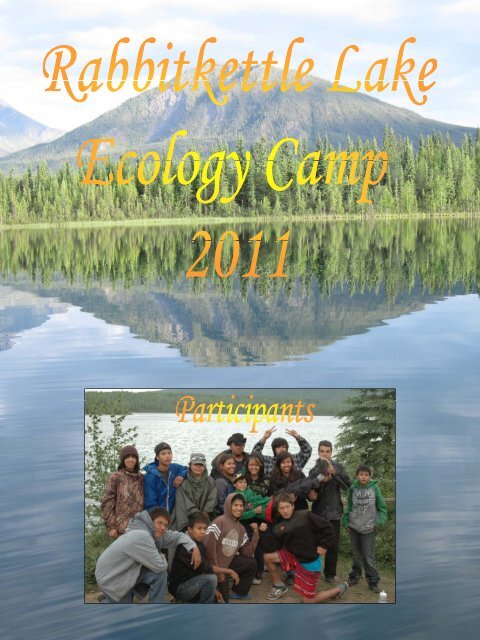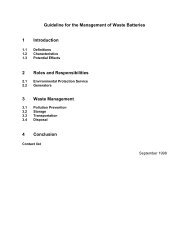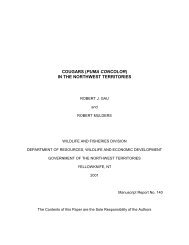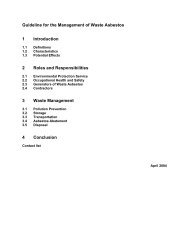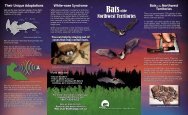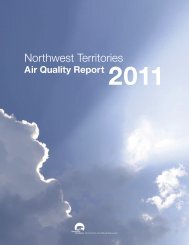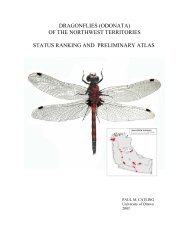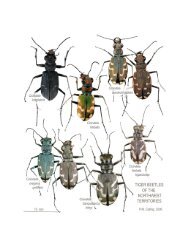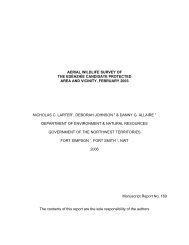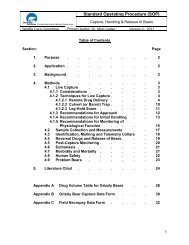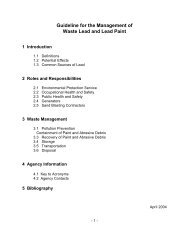Rabbitkettle Lake Camp 2011
Rabbitkettle Lake Camp 2011
Rabbitkettle Lake Camp 2011
Create successful ePaper yourself
Turn your PDF publications into a flip-book with our unique Google optimized e-Paper software.
Donovan PunchAge:17Trout <strong>Lake</strong>Randall HardistyAge:12Fort SimpsonRocky EllezeAge:17Fort ProvidenceDarius SabourinAge:14Fort SimpsonWilliam AlgerAge:12Fort SimpsonJohn AntoineAge:13Fort ProvidenceJade BonnetrougeAge:17Fort ProvidenceEdmund GarganAge:14Fort Providence
Megan BertrandAge:19Nahanni ButteDeidre YakinneaAge:15Nahanni ButteMindy TsetsoAge:16Nahanni ButteKevin RocheRobert HaroldAge:13Age:13Fort SimpsonFort SimpsonJames KonisentaAge:13Nahanni ButteTyler LaffertyAge:12Fort Simpson
Jerry AntoineInstructorNNPRCeline BetsakaCookNahanni ButteDoug TateInstructorNNPRAshley OKrainecInstructorNNPRBernice KonisentaCookNahanni ButteSandra EddaElderFort Simpson
Andrew BertrandElderNahanni ButteTeresa ByattTeacherFort SimpsonLogan McKaySummer StudentNNPRBruce TownsendInstructorAAROMTonya MakletzoffInstructorNNPRJordan SniderSummer StudentNNPRGeorge TsetsoInstructorNahanni Butte
After the students unloaded their gear and met everyone, theywere given an orientation of the camp, provided with the camprules, and assigned their accommodations. Students weregiven a water bottle and were shown how to filter their ownwater.Staff giving orientation to the students.<strong>Rabbitkettle</strong> <strong>Lake</strong> Ecology <strong>Camp</strong>.
Doug Tate, a Conservation Biologist with Nahanni National ParkReserve (NNPR) taught the students about bear safety. Hetaught the students how to properly store food while out on theland, they talked about leave no trace principles, and many otherhelpful safety tips were reviewed. Many different types of beardeterrents were explained and a bear banger was demonstrated.All staff and students watched a bear video in Fort Simpsonbefore flying out to the camp.Doug demonstrating to thestudents how a bearbanger works.Doug explaining to theg p gstudents what a bearbanger is.
Doug taught the students about the history of Parks in Canada andthe Nahanni National Park Reserve including its recent expansion toincorporate more of the South Nahanni Watershed. Ashley had thestudents guess the definition of the terminology they had on theirflashcards. Teresa and Ashley taught the students food webdynamics. Students were given field notebooks to write down dailyactivities that they were going to present at the end of camp.Doug providing the studentswith a bit of background onNahanni National Park Reserve+ all Parks in Canada.Teresa and Ashley teaching thestudents food web dynamics.Bruce and students holding uptheir flashcards before trying toguess the terminology.
Doug and Bruce taught the students water, boat and canoesafety. The students learned the importance of wearing alifejacket while in a boat and to have supplies onboard like apaddle, fire extinguisher, throwbag and a bailer. All activitieswere taught and practiced on dry land. The students took turnsrescuing each another with canoes. It was quite a popular eventfor the students who wholeheartedly participated in theexercise.Doug reviewing canoetechniques with the students.Students rescued each other afterlearning how to safely do so.Students getting the water out ofthe canoeStudents getting back into thecanoe
All staff and students had to wear life jackets during trips onthe lake and students had to be supervised while doingwater ecology activities on the lake. Each student was fittedwith a lifejacket according to their weight and size. Theweather was great for the duration of the camp, all waterrelated activities were the highlights for a lot of students.Students going for a boat ridewith Doug.Staff going for a canoe ride.Staff and students canoeing andswimming.<strong>Rabbitkettle</strong> <strong>Lake</strong>.
During the course of the camp, Bruce taught modules on waterecology to the students. Freshwater zooplankton, the water cycle,dissecting fish, contaminants and food web dynamics were some oftopics taught to the students. Students went out on field trips andused scientific equipment to do experiments. The zooplankton wereviewed under a microscope by the students. Bruce reviewed thesmall vessel operators handbook, some students and staff obtaineda Pleasure Craft Operator Card.Students conducting a battery teston water to demonstrate how wemonitor climate changes.Students made Mickey Mouse H 2 0water molecules out of water floats.Students looking at what theycaught with their nets.Students using a Seine Net inthe lake to catch aquatic life.
Bruce helping a student emptyhis net into a basin.Bruce explaining to the studentsthe different states of water.Students taking minnows out ofthe Seine Net.Students using their Plankton Netsto catch Plankton near the shore.Bruce teaching the students thedifferent parts of a dissected fish.Some of the minnows caught withthe Seine Net.
Doug and Teresa taught the students how to read maps, use acompass and how to make a map of the surrounding area. Studentslearned to use GPS units, and found their way to pre-set waypointsin the area. Celine talked about the <strong>Rabbitkettle</strong> area which is hertraditional area, she talked about travel routes that her family utilizedin the fall to hunt moose. When spring would come her family wouldgo downriver in moose-skin boats to trade for the upcoming winter.Students hiked to Tufa mounds and <strong>Rabbitkettle</strong> River.Doug showing the students atopographic map of the<strong>Rabbitkettle</strong> area.Celine telling stories about life on theland when she was young.Teresa getting the students to drawa map of the surrounding area.
Traditional knowledge was taught by Sandra Edda, JerryAntoine, George Tsetso, Celine Betsaka and Andrew Bertrand.Andrew showed the students how to properly set a tent andhow to set rabbit snares. George, Jerry, Andrew and Celine toldtraditional stories about the area and shared some of the historywith the students during the evenings. The instructors taughtthe students how to feed the fire and water. The students foundit quite interesting and participated every step of the way.Students walking to check theirspringpole rabbit snares.Andrew took some students out toget tent poles for their tents.Sandra showed the students some George Tsetso telling the studentsDene tools; this is how a moose scraper Dene legends of the area.is used to clean a moose hide.
Traditional games was taught by Jerry Antoine, George Tsetsoand Andrew Bertrand. Jerry showed the students how to playring toss, stick pull, finger pull, moose skin ball and beaver bonegames. All three instructors taught the students how to playhandgames. The students found it quite interesting and playedhandgames every night. Some tourists were able to join themon the last day for some friendly competition.Jerry showing the students how toplay the beaver bone game.Students enjoying a game of ringtoss.Students playing a game of stickpull.Students playing handgames withsome tourists.
Staff and students hiked to Tufa Mounds, a unique geologicalfeature near the camp. Everyone had lunch at <strong>Rabbitkettle</strong>River before returning back to camp. The weather was niceand everyone enjoyed the hike. Sandra showed the studentsimportant medicinal plants and George showed them how toidentify animal tracks seen along the way.Staff posing with Tufa Mounds inthe background.Students and staff taking a breakduring the hike out to Tufa Mounds.Students stopped to enjoy theview of <strong>Rabbitkettle</strong> River valley.Students paying respect to thewater at <strong>Rabbitkettle</strong> River.
Elder Sandra Edda taught how to identify medicinal plants ofthe boreal forest during the hike to Tufa Mounds. The studentshad cards to identify and look for certain plants on the hike.They also were required to number 3 plants and their traditionalmedicinal uses which they took field ednotes of intheir log books.The students found it quite interesting and eagerly participatedin looking for medicinal plants.Sandra showing the students someimportant medicinal plants duringthe Tufa Mounds hike.Students listening to Sandraexplain the importance of medicinalplants to the Dene.
Tonya taught the students about reducing their footprint on theenvironment. Tonya discussed the differences betweentraditional and domestic food sources and how they impact theenvironment. Tonya asked the students how they could reducetheir impact on the environment.e The students ts each made apledge by adding one action item they will do when they returnhome, all pledges were written down on leaves and used tomake a tree.Students explaining theirpledges to the group.Tonya helping students puttheir pledge on the tree.
During the camp all of the students kept a journal that they filledout daily. At the end of the camp the students made apresentation of what they learned and what was their favoriteactivity at the camp to the group.Students highlight what they learned and liked at thecamp..
During their spare time students spent time swimming,listening and socializing. They were supervised duringswimming and other water activities. Evening activitiesincluded elder story telling, card games, and snacks. Therewere tourists that regularly came during the camp to visit.The students thoroughly enjoyed their free time and got toknow each other quite well.Students and staff taking a breakfrom the hot weather.Students and staff used the old dockas a makeshift raft.Students and staff going for a ridewith the raft.George telling the students storiesabout the land.
This year there was no community feast to end the camp. Due toinclement weather and the rides for students from outside FortSimpson, two flights out were required for camp participants;Thursday 14 th evening and Friday 15 th morning. The elders,supervisors and facilitators played an key role in the ecologycamp’s success as did the group of students from throughout theDehcho. All students wholeheartedly participated in and becameinvolved with all of the different experiences provided to themduring the camp. The students thoroughly enjoyed themselves atthe <strong>2011</strong> camp and made friendships that will last a lifetime.Staff out for a canoe ride.Some resident loons at <strong>Rabbitkettle</strong>.Emerald <strong>Lake</strong>.Sunset over <strong>Rabbitkettle</strong> <strong>Lake</strong>.
During the last regional wildlife workshop held in October 2010, there wasconsensus that the youth ecology camp should continue to be held at differentlocations throughout the Dehcho Region. The 2003 and 2004 camps had been heldat the Trout <strong>Lake</strong> Fire Base. By holding the campin different locations this wouldallow different communities the opportunity of hosting and conducting the youthecology camp as well as providing the chance for participants to experiencedifferent areas of the Dehcho. A joint DFN/ENR committee reviews the proposalsand awards the camp. The 2005 camp was held near Jean Marie River and hostedby Land is Life. The 2006 camp was held near Hay River Reserve and was hostedby the Katlodeeche First Nation. The 2007 and 2009 camps was held at Cli <strong>Lake</strong>west of Fort Simpson and were hosted by North Nahanni Naturalist Lodge Ltd. The2008 camp was held at Paradise creek near Trout <strong>Lake</strong> and was hosted by theSambaa K’e Development Corporation. The 2010 camp was held at Ekali <strong>Lake</strong> andhosted by the Jean Marie River First Nation. This year’s camp was held at<strong>Rabbitkettle</strong> <strong>Lake</strong> and hosted by Nahanni Butte Dene Band/ Parks Canada.Wewould like to thank AAROM for providing additional funding and expertise for thecamp this year, without their help we would have been unable to hold a camp thisyear.Previous camps taught a variety of traditional and scientific skills. This year’s camphad a great mixture of both. This was the first year students were able to get a CTShigh school credit. Students learned a lot of new tools which should help them infuture endeavours. Once again we appreciate all the work the instructors and eldersdid this year to ensure a most memorable experience for all those who attended.


